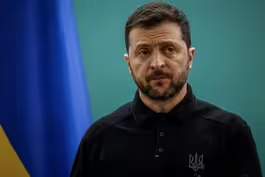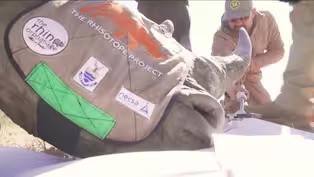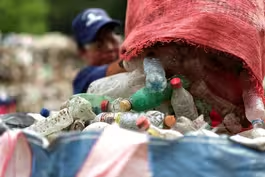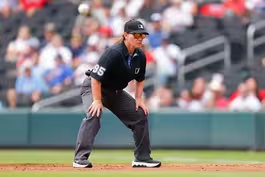
New book recounts megafire season with Los Padres Hotshots
Clip: 8/9/2025 | 5m 33sVideo has Closed Captions
‘When It All Burns’ recounts a historic megafire season with the elite Los Padres Hotshots
The Gifford Fire in Southern California has reached “megafire” status, burning an area bigger than Atlanta. Megafires, which burn more than 100,000 acres, have become increasingly common in recent years. A new book, “When It All Burns: Fighting Fire in a Transformed World,” is the first-hand account of a season with a team of elite firefighters. John Yang speaks with author Jordan Thomas for more.
Problems playing video? | Closed Captioning Feedback
Problems playing video? | Closed Captioning Feedback
Major corporate funding for the PBS News Hour is provided by BDO, BNSF, Consumer Cellular, American Cruise Lines, and Raymond James. Funding for the PBS NewsHour Weekend is provided by...

New book recounts megafire season with Los Padres Hotshots
Clip: 8/9/2025 | 5m 33sVideo has Closed Captions
The Gifford Fire in Southern California has reached “megafire” status, burning an area bigger than Atlanta. Megafires, which burn more than 100,000 acres, have become increasingly common in recent years. A new book, “When It All Burns: Fighting Fire in a Transformed World,” is the first-hand account of a season with a team of elite firefighters. John Yang speaks with author Jordan Thomas for more.
Problems playing video? | Closed Captioning Feedback
How to Watch PBS News Hour
PBS News Hour is available to stream on pbs.org and the free PBS App, available on iPhone, Apple TV, Android TV, Android smartphones, Amazon Fire TV, Amazon Fire Tablet, Roku, Samsung Smart TV, and Vizio.
Providing Support for PBS.org
Learn Moreabout PBS online sponsorshipJOHN YANG: California fire officials say a massive wildfire in Southern California has reached mega fire status.
Fueled by near 100 degree heat and bone dry conditions, the Gifford fire north of Santa Barbara has already burned more than 104,000 acres.
That's an area bigger than Atlanta.
Mega fires, which burned more than 100,000 acres have become increasingly common in recent years, testing the men and women who fight them.
A new book, "When It All Burns: Fighting Fire in a Transformed World" is the firsthand account of a season with a team of elite firefighters, the Los Padres Hotshots.
The author is Jordan Thomas, who's also anthropologist.
Jordan Thomas, help us understand what is it like to be on the front lines of a wildfire.
JORDAN THOMAS, Author, When It All Burns: Fighting Fire in a Transformed World": These are some of the largest wildfires that humans have ever encountered in our recorded history.
So science is having a hard time even understanding what these wildfires are going to do.
So what it's actually like to fight wildfires is you're living on some of the most extreme edges of the climate crisis in triple digit heat, basically mountaineering with chainsaws to remove fuel from the edges of fires.
And so it takes an extreme amount of tactical athleticism and a really intense level of knowledge of landscapes and fire behavior as well.
JOHN YANG: Talk about that knowledge of landscapes.
You've got to be constantly assessing the landscape as you're fighting the fire, right?
JORDAN THOMAS: Right, yeah, exactly.
So you have to be paying attention to the vegetation, to the slope of the landscape, and to changes in all these different weather patterns, including the temperature, the humidity and the wind.
Because all of these things change what fire does.
And when you're working on the edges of fires, day after day, hour after hour, week after week, any of these changes can put you in extremely dangerous situations.
JOHN YANG: The point you made at the beginning about how these wildfires are different or seem to be different, you write in the book that the recent wildfires have transformed fundamental assumptions about how fireworks.
Explain that.
JORDAN THOMAS: So people I've worked with, when they started their career, they may have encountered one megafire in their entire career, but there's multiple megafires burning across the American west now.
We fought four during the time I was writing the book.
They're becoming common.
18 of the 20 largest wildfires in California's recorded history of burning just the past two decades.
So what does that mean?
In a fundamental sense it means that we often don't know what these fires are going to do day by day.
We don't know what their ecological impacts are going to be, we don't know how they're going to behave.
And that sounds dangerous in an abstract sense, but it's also incredibly dangerous for wildland firefighters on the ground.
For example, fires, usually, their behavior usually really calms down at night.
That's what we've come to expect.
In 2020 a wildfire that I was on, it doubled in size overnight after we almost had it contained, and it overtook 15 firefighters and a lot of them were injured.
So things with the climate crisis that seem abstract are often matters of life and death for wildland firefighters.
JOHN YANG: And talk about that effect.
The climate crisis, how is the climate crisis affecting this?
JORDAN THOMAS: So you have multiple layers.
On a broad layer, you have broad changes in temperature across entire landscapes.
It takes more water out of the vegetation, out of the trees, dries them out, makes them more flammable.
You have other changes that intersect with that.
Like there's less precipitation falling as snow.
That means that there's less water running throughout the landscapes and snow melt throughout the year, which means that the lands dry out quicker.
Layer drought on top of that layer, insect infestations on top of that, you get really sick landscapes.
And then you're also way more likely to have intense heat waves.
And that just sucks the rest of the moisture out of the landscapes as well.
And you get really explosive fire behavior.
Then when you get these unprecedented heat waves, you know, like 120 degrees, that also makes them way more difficult to suppress, which endangers communities and in the area as well.
So, there's multiple layers, but they all intersect with climate change in a really dangerous, explosive situation.
JOHN YANG: In terms of history, in your book you talk about how centuries ago, the indigenous people in California coexisted with fire, lived with fire, but then the white European settlers came in and the focus became on fire suppression.
What effect did that have?
JORDAN THOMAS: So it's important to keep in mind when we're talking about this, that California is one of the most fire evolved regions on Earth.
Many of the ecosystems and many of the plant species actually rely on fire to reproduce.
Now indigenous people knew this and lived in California for at least 10,000 years before Europeans arrived.
And plants were the basis of indigenous economies.
So, indigenous people knew to use fire to shape sorts of plants that they needed.
And this really transformed California's ecosystem.
So most of the fire California encountered was actually lit by indigenous people before Europeans arrived.
So one of the first acts that Europeans did when they took over the Spanish, they criminalized the use of fire as a way to criminalize indigenous economies.
Now this was a start of a long history of fire suppression that went from that first criminalization up until the modern day, where we treat fire as an enemy, where we try to put fire out.
When you take fire away from landscapes that need it, you make those landscapes sick.
You get fuels accumulation in forests.
You get insect infestations that you wouldn't otherwise if you were burning.
And the culmination of this is you sort of lay the kindling that climate change is really.
It's like dropping a match on top of the kindling.
JOHN YANG: Jordan Thomas, author of "When It All Burns," thank you very much.
JORDAN THOMAS: Thank you.
News Wrap: Zelenskyy says Ukraine won’t cede land to Russia
Video has Closed Captions
Clip: 8/9/2025 | 2m 37s | News Wrap: Zelenskyy says Ukraine won’t give up territory to end war with Russia (2m 37s)
Scientists make rhino horns radioactive to fight poachers
Video has Closed Captions
Clip: 8/9/2025 | 2m 9s | How radioactive rhino horns could help save the species from poachers (2m 9s)
Study highlights ‘grave’ health dangers of plastic pollution
Video has Closed Captions
Clip: 8/9/2025 | 4m 48s | New study highlights ‘grave, growing’ danger of plastic pollution to world’s health (4m 48s)
What Pawol’s MLB debut means for the future of women umpires
Video has Closed Captions
Clip: 8/9/2025 | 5m 31s | What Jen Pawol’s debut means for the future of women umpires in Major League Baseball (5m 31s)
Providing Support for PBS.org
Learn Moreabout PBS online sponsorshipSupport for PBS provided by:
Major corporate funding for the PBS News Hour is provided by BDO, BNSF, Consumer Cellular, American Cruise Lines, and Raymond James. Funding for the PBS NewsHour Weekend is provided by...















